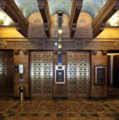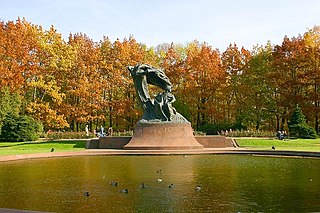
Łazienki Park or Royal Baths Park is the largest park in Warsaw, Poland, occupying 76 hectares of the city center.

Old State Library Building is a heritage-listed former library building at 159 William Street, Brisbane City, City of Brisbane, Queensland, Australia. It is also known as the former Queensland Museum. It was added to the Queensland Heritage Register on 21 October 1992.

The Petit Palais is an art museum in the 8th arrondissement of Paris, France.

Noravank is a 13th-century Armenian monastery, located 122 km from Yerevan in a narrow gorge made by the Amaghu River, near the town of Yeghegnadzor in Armenia. The gorge is known for its tall, sheer, brick-red cliffs, directly across from the monastery. The monastery is best known for its two-storey Surb Astvatsatsin Church, which grants access to the second floor by way of a narrow stone-made staircase jutting out from the face of building.

Edgar Johan Kuusik was an Estonian architect and furniture and interior designer.
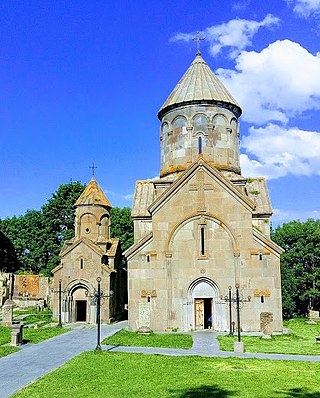
Kecharis Monastery, is a medieval Armenian monastic complex dating back to the 11th to 13th centuries, located 60 km from Yerevan, in the ski resort town of Tsaghkadzor in Armenia. Nestled in the Pambak mountains, Kecharis was founded by a Pahlavuni prince in the 11th century, and construction continued until the middle of the 13th century. In the 12th and 13th centuries, Kecharis was a major religious center of Armenia and a place of higher education. Today, the monastery has been fully restored and is clearly visible from the ski slopes.

The Garfield Building is a thirteen-story Art Deco style historic structure in Los Angeles, California. Designed by American architect Claud Beelman, construction lasted from 1928 to 1930. It is listed on the National Register of Historic Places.

Makaravank is a 10th-13th century church complex near the Achajur village of Tavush Province, Armenia, located on the slope of Paitatap Mountain. The complex of Makaravank ranks among Aghtamar, Bgheno-Noravank, Gandzasar with its originality, richness and variety of ornaments and occupies an important place in Armenian architecture.
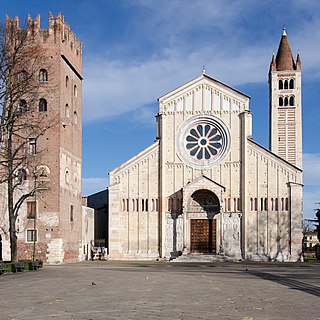
The Basilica di San Zeno is a minor basilica of Verona, northern Italy constructed between 967 and 1398 AD. Its fame rests partly on its Romanesque architecture and partly upon the tradition that its crypt was the place of the marriage of Shakespeare's Romeo and Juliet. It stands adjacent to a Benedictine abbey, both dedicated to St Zeno of Verona.

195 Broadway, also known as the Telephone Building, Telegraph Building, or Western Union Building, is an early skyscraper on Broadway in the Financial District of Manhattan in New York City. The building was the longtime headquarters of AT&T Corp. and Western Union. It occupies the entire western side of Broadway from Dey to Fulton Streets.

Burt William Johnson was an American sculptor.

Sanahin Monastery is an Armenian monastery founded in the 10th century in Sanahin in the Lori Province of Armenia.

The Spring Street Courthouse, formerly the United States Court House in Downtown Los Angeles, is a Moderne style building that originally served as both a post office and a courthouse. The building was designed by Gilbert Stanley Underwood and Louis A. Simon, and construction was completed in 1940. It formerly housed federal courts but is now used by Los Angeles Superior Court.
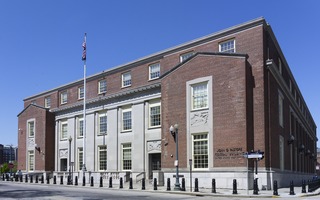
The John O. Pastore Federal Building is a courthouse of the United States District Court for the District of Rhode Island located in Providence, Rhode Island. The building also houses a post office.

Sedgwick Gardens, located at 3726 Connecticut Avenue, NW, Washington, DC, is an apartment building on the southwest corner of Connecticut Avenue and Sedgwick Street in Northwest Washington D.C. It is located two blocks from the Cleveland Park Metro. It is listed in the National Register of Historic Places, and represents a significant example of an Art Deco porte-cochere architecture in Washington.

Neoclassical architecture in Milan encompasses the main artistic movement from about 1750 to 1850 in this northern Italian city. From the final years of the reign of Maria Theresa of Austria, through the Napoleonic Kingdom of Italy and the European Restoration, Milan was in the forefront of a strong cultural and economic renaissance in which Neoclassicism was the dominant style, creating in Milan some of the most influential works in this style in Italy and across Europe. Notable developments include construction of the Teatro alla Scala, the restyled Royal Palace, and the Brera institutions including the Academy of Fine Arts, the Braidense Library and the Brera Astronomical Observatory. Neoclassicism also led to the development of monumental city gates, new squares and boulevards, as well as public gardens and private mansions. Latterly, two churches, San Tomaso in Terramara and San Carlo al Corso, were completed in Neoclassical style before the period came to an end in the late 1830s.

The architecture of Paris created during the Belle Époque, between 1871 and the beginning of the First World War in 1914, was notable for its variety of different styles, from neo-Byzantine and neo-Gothic to classicism, Art Nouveau and Art Deco. It was also known for its lavish decoration and its imaginative use of both new and traditional materials, including iron, plate glass, colored tile and reinforced concrete. Notable buildings and structures of the period include the Eiffel Tower, the Grand Palais, the Théâtre des Champs-Élysées, the Gare de Lyon, the Bon Marché department store, and the entries of the stations of the Paris Metro designed by Hector Guimard.

The Lavirotte Building, an apartment building at 29 Avenue Rapp in the 7th arrondissement of Paris, France, was designed by the architect Jules Lavirotte and built between 1899 and 1901. The building is one of the best-known surviving examples of Art Nouveau architecture in Paris. The facade is lavishly decorated with sculpture and ceramic tiles made by the ceramics manufacturer Alexandre Bigot. Lavirotte was awarded the prize for the most original new facade in the 7th arrondissement in 1901.
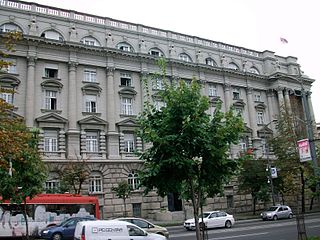
The Army Headquarters Building, also known as the Stone Palace and the Baumgarten's Palace, is located in Serbia, in Belgrade at 33 Kneza Miloša street. It was built in the period from 1924 to 1928 after the design of the architect, Russian immigrant, Vasily Wilhelm Baumgarten. This monumental and decorative building represents one of the best examples of public buildings erected in Belgrade in the period between two World Wars in the style of academism. After the Second World War in the time of the Socialist Federal Republic of Yugoslavia, it was the used as the headquarters of the Yugoslav People's Army. Since 1984 the building has been under the protection of the country and has the status of cultural monument.

The Gran Garaje is an Art Nouveau building dating from 1915, located in the city centre of Pontevedra, Spain.






